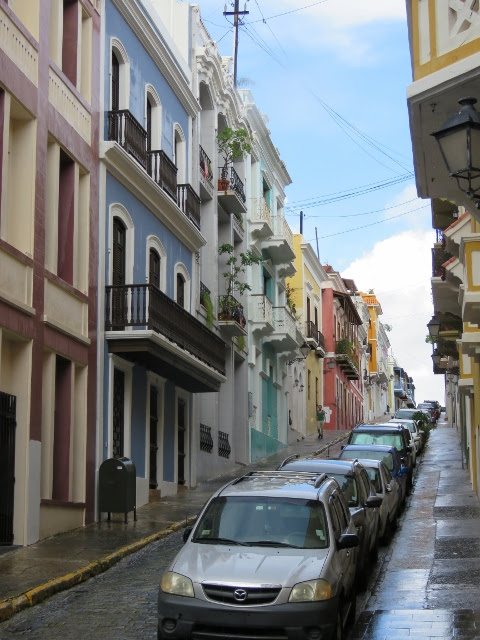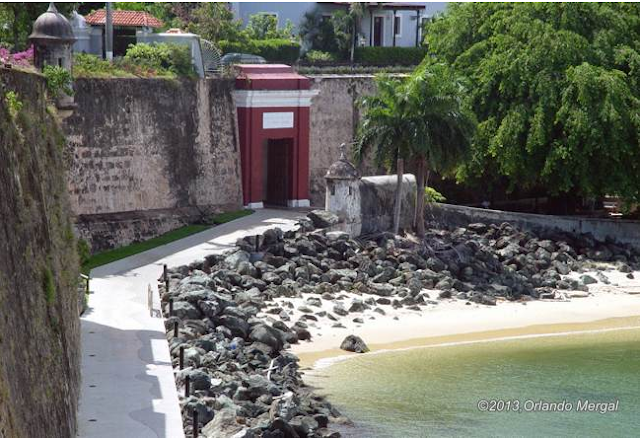Friday, October 25, 2019, Old San Juan, Puerto Rico
San Juan’s Old Town boasts
500 years of history, colonial architecture splashed with tropical colors, and
a relaxed, timeless appeal. Perhaps
nothing captures the history of Puerto Rico more than Old San Juan’s massive fortresses. El Morro and Castillo de San Cristobal’s
cannons, ramparts, and layered defenses have guarded the walled city for
centuries. One of the earliest
structures in Old Town, La Casa Blanca, was both its earliest fortress, built
in 1521, and home to its earliest ruling family, the de Leons. Although conquistador Juan Ponce de Leon died
before ever living there-having departed Puerto Rico for the Bahamas in search
of the mythical Fountain of Youth-his descendants occupied La Casa Blanca for
200 years. Today, it is a historical
monument and museum dedicated to depicting 16th- and 17th-century
exploration and culture.
Historic Old San Juan by Foot
During today's excursion, we explored the important monuments and plazas of historic Old San Juan by foot. We began our guided walk at the vast Fort San Cristóbal, the largest fortress built by Spain in the New World, where we paused for photos of the mighty citadel and its stunning Caribbean backdrop. We enjoyed sweeping views of the bay and the governor’s mansion at the Plazuela de la Rogativa, which commemorates the city’s miraculous evasion from sacking by the British during the 16th century. We passed the San Juan Gate, an impressive remnant of the three-mile-long wall that once encircled the city. We admired the history-rich Plaza de San José and the neoclassical-style Cathedral of San Juan Bautista, one of the city’s oldest buildings and the oldest cathedral in the US. We strolled to the Plaza de Armas, where we viewed the Four Seasons Fountain.
We began our walk at 9 AM; our first stop was at Plaza Arturo Somohano.
Our second stop was at Plaza de Colon (Columbus, as in Christopher).
Christopher Columbus Statue
The highlight of Colon Plaza is the statue of Christopher Columbus in the middle of the plaza. The statue features Christopher Columbus standing regally on top of a pillar with ships and sea serpents coming out of the base.
A fountain surrounding the statue shoots streams of water towards the base of the statue.
The statue commemorates the 400th anniversary of the discovery of Puerto Rico by Christopher Columbus on his second voyage to the new world. Christopher Columbus originally named the entire island of Puerto Rico to be San Juan Bautista (Saint John the Baptist), however the island was later renamed and only the capital city of San Juan retains the name. Bronze plaques on the base of the monument provide pectoral representations of the ocean journey and arrival of Christopher Columbus and the meeting of the indigenous people.
Castillo San Cristóbal, is a fortress in San Juan, Puerto Rico. It was built by Spain to protect against land based attacks on the city of San Juan. It is part of San Juan National Historic Site.
Castillo San Cristóbal is the largest fortification built by the Spanish in the New World. When it was finished in 1783, it covered about 27 acres of land and basically wrapped around the city of San Juan. Entry to the city was sealed by San Cristóbal's double gates. After close to one hundred years of relative peace in the area, part of the fortification (about a third) was demolished in 1897 to help ease the flow of traffic in and out of the walled city.
This fortress was built on a hill originally known as the Cerro de la Horca or the Cerro del Quemadero, which was changed to Cerro de San Cristóbal in celebra-tion of the Spanish victories ejecting English and Dutch interlopers from the island of this name in the Lesser Antilles, then forming part of the insular terri-torial glacis of Puerto Rico.
Castillo de San Cristóbal also contains five cisterns that were used for the storage of water during the ages of the Spanish Colony. They are extremely large (24 ft tall, 17 ft wide and 57 ft long) and were used as bomb shelters during World War II. They could be used for a future war again with some refurbishments.












Fort San Felipe del Morro (background); located at entrance to Bar Channel.
Dark dungeon.
Ships etched on dungeon walls; presumed to be done by officer prisoners.
Views through openings in walls for canon barrels.
Capital building.
Our cruise ship (between buildings along waterfront.
Concrete tower added to watch for German U-boats in WW II.
Looking down on Christopher Columbus' statue.
Walking to Plaza de Armas; we had to duck for cover during a 20-30 minute rain.
Looks like New Orleans.
Centuries old cobble stone street; very slippery when wet.
Old City Hall across from Plaza de Armas.
The Plaza de Armas of San Juan is one of the main squares in San Juan, the capital of Puerto Rico. It is located on San José Street in Old San Juan, and was designed to serve as the original main square for the city. San Juan City Hall is located to the north of the square, while the Puerto Rico Department of State (background of picture) lies at the west.
The square's main feature is a round fountain with four marble statues repre-senting "The Four Seasons," originally placed in the four corners of the square, which had been commissioned in 1856 to the "motherland," to be placed in Paseo La Princesa esplanade in Old San Juan.
The Catedral Metropolitana Basílica de San Juan Bautista, or in English, Metropolitan Cathedral Basilica of Saint John the Baptist, is the Roman Catholic cathedral of the Archdiocese of San Juan de Puerto Rico. The cathedral is one of the oldest buildings in San Juan, located in Old San Juan, the oldest cathedral in the United States, and is the second oldest cathedral in the Ameri-cas. Even though the Cathedral of Santa María la Menor in Santo Domingo in the Dominican Republic, is an older church building, the Cathedral of San Juan Bautista was the first cathedral church in the Americas as San Juan, then known as the city of Puerto Rico, was the first diocese of the New World with bishop Don Alonso Manso in 1511. A private Puerto Rican foundation known as Fundación Protectora de la Catedral Metropolitana de San Juan, Inc. has been established to fund the historical restoration of the building and its art treasures for its 500th anniversary in 2021, and to protect it for coming centuries.
https://en.wikipedia.org/wiki/Catedral_Metropolitana_Bas%C3%ADlica_de_San_Juan_Bautista_(San_Juan,_Puerto_Rico)
Tomb of Juan Ponce de León (1474 – July 1521), commonly known as Ponce de León, was a Spanish explorer and conquistador known for leading the first official European expedition to Florida and the first governor of Puerto Rico. He was born in Santervás de Campos, Valladolid, Spain in 1474. Though little is known about his family, he was of noble birth and served in the Spanish military from a young age. He first came to the Americas as a "gentleman volunteer" with Christopher Columbus's second expedition in 1493.
Hotel out the door of the cathedral.
San Juan Gate.
These statues are meant to honor the legend of San Juan, which goes as far back as 1797 and tells of time when a miracle occurred saving San Juan from a certain attack. Lindsay Daen who was born in Dunedin in New Zealand in 1923 sculptured these four bronze statues that overlook the old city’s walls in 1971 to commemorate San Juan’s 450th year anniversary.
The legend starts off with the British wanting to attack the city of San Juan. The British fleet was anchored in the San Juan Bay just outside the city walls in an attempt to starve the native people of provisions. They knew that by blocking the entrance into the bay needed supplies would not be able to come in and this would cause havoc among the local people. At that point the governor of the city was at a loss as to what to do and so ordered a “rogativa” or religious procession to try and get the saints to assist them.
They locals knew that the Spanish reinforcements inland might take ages to come and that there would be an invasion of the city if something was not done. So the bishop and his congregation took it upon themselves to march through the city in an attempt to get the saints to help them. While they marched through the city they sang hymns and carried torches in their attempt to invoke help against the potential attack.
This procession of unarmed men and women was more effective then they had ever hoped it would be. On seeing the torches of the procession the British fleet came under the impression that the reinforcements had unexpectedly arrived early. The march scared off the potential invaders who left immediately aband-oning their siege.
Governor's offices with residence on top floor.
"1753 Catholic Chapel"
Capilla de Cristo, the Chapel of Christ, was built as a memorial to a celebrated miracle. In 1753, a youth participating in a horse-race at the St. John's Day festival lost control of his horse and plunged over a precipice. Don Mateo Pratts, a secretary of the city, prayed to Christ to spare the boy's life and the youth was saved. To express his gratitude, the young man had the chapel erected later that same year. Today, the chapel, located on Calle Cristo near Paseo de la Princesa, is a landmark and its Campeche paintings and gold and silver altar are highlights.
This man bought a small bag of corn from a vendor to feed the pigeons.
The man tossed a handful of corn into the air; most of the pigeons flew up to catch a kernel in flight.

Our cruise ship from the Chapel of Christ the Savior.
We will depart Puerto Rico at 6 PM and head for Barbados. Tomorrow will be a sea day, much needed after a marathon of a week of shore days with excursions each day.






























































































Comments
Post a Comment